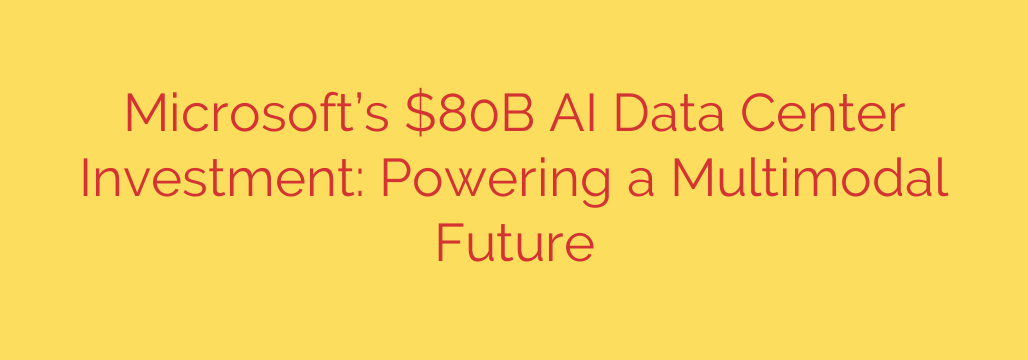
Inside Microsoft’s $80 Billion Push to Dominate the Future of AI
The world of artificial intelligence is moving at a breakneck pace, and major tech players are making unprecedented investments to secure their place at the forefront. Microsoft is making one of the boldest moves yet, signaling a massive commitment to an AI-powered future with a staggering $80 billion investment in next-generation data centers. This isn’t just about building more servers; it’s a strategic plan to construct the foundational infrastructure for a new era of computing.
This monumental investment is aimed squarely at building the physical backbone required to power the next wave of innovation: multimodal generative AI. Let’s break down what this massive spending spree means for technology, business, and the future of how we interact with the digital world.
Powering the Multimodal AI Revolution
For years, AI has largely operated in distinct silos. You had AI that could write text, AI that could generate images, and AI that could understand speech. The future, however, is multimodal.
Multimodal AI is artificial intelligence that understands and generates content across various formats—text, images, audio, and video—simultaneously. Imagine asking an AI assistant to create a video presentation based on a simple text prompt, complete with a script, relevant images, a voiceover, and background music. This is the power of multimodal AI, and it requires an immense amount of computational power that current infrastructure struggles to provide at scale.
Microsoft’s investment is a direct response to this need. By building out a global network of advanced data centers, the company is preparing for a world where AI interactions are richer, more complex, and seamlessly integrated into every application. This move is designed to ensure its Azure cloud platform remains the premier destination for developers and businesses building these sophisticated AI models.
The Anatomy of an AI Super-Infrastructure
What does $80 billion actually buy? This investment goes far beyond simple servers and storage. The key components include:
- Advanced GPU Clusters: The engine of the AI revolution is the Graphics Processing Unit (GPU). These data centers will be packed with hundreds of thousands of the most advanced GPUs, likely from partners like NVIDIA, which are essential for training and running large language models (LLMs) and other generative AI systems.
- High-Speed Networking: Processing massive datasets for AI requires incredibly fast connections between servers. This investment will fund custom, high-bandwidth networking fabric to ensure data flows without bottlenecks, a critical factor for AI performance.
- Innovative Cooling and Power Solutions: AI data centers are incredibly power-hungry and generate immense heat. A significant portion of the budget is dedicated to developing sustainable and efficient cooling systems and securing the vast amounts of energy needed to keep these facilities running 24/7. This is one of the biggest challenges in the AI arms race.
By building this hyper-specialized infrastructure, Microsoft aims to create an unbeatable competitive advantage. It’s a move to ensure that when companies look for a platform to build the next groundbreaking AI application, Azure is the only logical choice.
What This Means for Businesses and Developers
This massive infrastructure build-out has direct implications for organizations of all sizes. The race to integrate AI is on, and being prepared is crucial.
Prepare for a Multimodal World: Businesses should start thinking beyond text-based chatbots. Consider how AI that understands images, audio, and video could transform your products, services, and internal operations. Customer service, content creation, and data analysis are all ripe for multimodal disruption.
Prioritize AI Security and Governance: As AI systems become more powerful and integrated, the security risks multiply. It is essential to develop strong governance frameworks for AI use. Focus on data privacy, model security, and establishing clear guidelines for responsible AI deployment. The more capable the AI, the more critical it is to have robust security protocols in place to prevent misuse.
Leverage Cloud Platforms for Innovation: Building your own AI infrastructure on this scale is impossible for all but a handful of global corporations. This investment reinforces the importance of cloud platforms. Businesses should focus on learning how to effectively leverage the powerful AI services offered by providers like Microsoft Azure. This allows you to tap into world-class infrastructure without the prohibitive upfront cost.
Ultimately, Microsoft’s $80 billion plan is more than just a financial headline. It is a clear declaration that the future of technology will be built on a foundation of artificial intelligence. By constructing the “digital factories” of tomorrow, the company is not just preparing for the future—it’s actively building it.
Source: https://www.datacenters.com/news/microsoft-s-80b-investment-in-ai-data-centers-the-digital-backbone-for-a-multimodal-world








